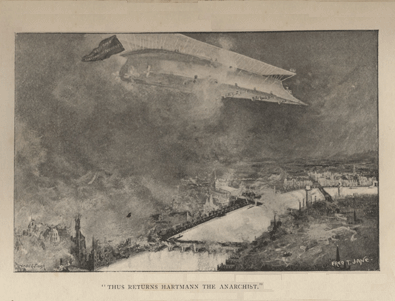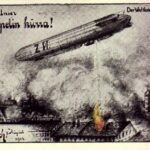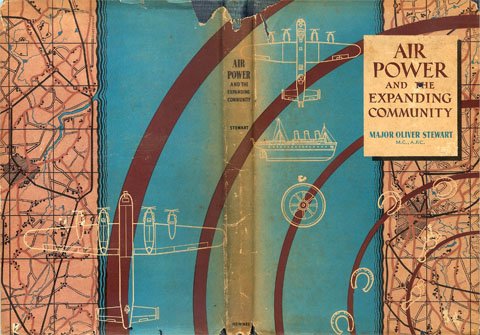
The degree to which science fiction accurately predicts the future is not really the point; its value is more as an exploration of what people might do and what society might look like if you change things in a few fundamental ways. (And for my purposes, it’s the assumptions underlying a given exploration which are most interesting.) Nevertheless it’s always fun when somebody does get it right. Take this description of Britain in 1920 — written in 1893:
Things had been looking very black in the closing years of the last century, but the pessimists of that epoch were the optimists of ours. London even in the old days was a bloated, unwieldy city, an abode of smoke and dreariness startled from time to time by the angry murmurs of labour. In 1920 this Colossus of cities held nigh six million souls, and the social problems of the past were intensified. The circle of competence was wider, but beyond it stretched a restless and dreaded democracy. Commerce had received a sharp check after the late Continental wars, and the depression was severely felt. That bad times were coming was the settled conviction of the middle classes, and to this belief was due the Coalition government which held sway during the year in which my story opens. In many quarters a severe reaction had set in against Liberalism, and a stronger executive and repressive laws were urgently clamoured for. At the opposite extreme flew the red flag, and a social revolution was eagerly mooted.1
It’s not too far off, is it: the expansion of democracy, recent war (OK, wars) in Europe, a post-war slump (if you ignore the post-war boom just before that), a Coalition government, the decline of Liberalism, the rise of Labour (the narrator is a parliamentary candidate for a non-revolutionary socialist party), fears (or hopes) of revolution. The above quote is from the 1893 novel Hartmann the Anarchist; or, The Doom of the Great City;2 the author, Edward Douglas Fawcett, mainly extrapolated two trends of his own day, the beginnings of organised labour and the anarchist terror. In the novel he allies these to a revolution in flight, an aëronef (the Attila) powered by coal-fired electricity and which derives its lift from hydrogen gas-meters and ‘an inclined plane driven rapidly through the air by a screw, a device first prominently brought into notice by the nineteenth-century experiments of Maxim‘.3 The inventor, Hartmann, and his band of merry anarchists proceed to shell, bomb and burn much of London, as the beginnings of their plans to destroy civilisation and replace it with anarchy:
“But how is the new order to take shape? How educe system from chaos?”
“We want no more ‘systems,’ or ‘constitutions’ — we shall have anarchy. Men will effect by voluntary association, and abjure the foulness of the modern wage-slavery and city-mechanisms.”
“But can you expect the more brutal classes to thrive under this system. Will they not rather degenerate into savagery?”
“You forget the Attila will still sail the breeze, and she will then have her fleet of consorts.”
“What! You do not propose, then, to leave anarchy unreasoned?”
“Not at once — the transition would be far too severe. Some supervision must necessarily be exercised, but, as a rule, it will never be more than nominal.”4
There’s more than a hint here (though not much more) of both Kipling’s “As easy as ABC” and Wells’s The Shape of Things to Come. Other parts of the book anticipate elements of the knock-out blow, specifically the panic of crowds under air attack and the vulnerability of economies to bombing, so I’m going to have to say more about it in my thesis than I was planning to (that is, more than I was planning to before having read it!)
Edward Douglas Fawcett seems to have been an interesting chap himself. His younger brother Percy was later to become famous as an explorer; he disappeared in the Amazon in 1925 while searching for the lost city of Z. Douglas was a philosopher (writing several books about idealism) and a Theosophist; yet he evidently shared the physicality of his brother, for he was also a skilled mountain-climber, skier and motorcycle racer. He moved to Switzerland, and last completed a climb to the top of the Matterhorn at age 66, suffering a heart attack on the way up; he never climbed it again, but instead learned to fly so he could still be among the mountain peaks. According to his Times obituary, he was able to continue flying until 1950, when he was 84. The same obituary notes that Fawcett was ‘well ahead of H. G. Wells’ in his science fiction, not only for Hartmann the Anarchist in its depiction of the bombing of London, but also for ‘his The Secret of the Desert (1894) [which] was, surely, fiction’s first account of an armoured fighting vehicle in the modern sense’.5 Must … fight … urge … to look at … irrelevant books!
Image source: Silent S. F.; it’s from page 145 of the novel.
![]() This work is licensed under a Creative Commons Attribution-NonCommercial-NoDerivatives 4.0 International License.
Permissions beyond the scope of this license may be available at http://airminded.org/copyright/.
This work is licensed under a Creative Commons Attribution-NonCommercial-NoDerivatives 4.0 International License.
Permissions beyond the scope of this license may be available at http://airminded.org/copyright/.
- E. Douglas Fawcett, Hartmann the Anarchist; or, The Doom of the Great City (London: Edward Arnold, 1893), 4-5. [↩]
- Which I see occasional commenter Jess Nevins found much less interesting than I did — in fact he calls it ‘A colorless and joyless novel with little to recommend it […] a must-avoid’! — but that’s the advantage I have as an airminded monomaniac :) [↩]
- Hartmann the Anarchist, 88. [↩]
- Ibid., 84-5. [↩]
- The Times, 18 April 1960, p. 10. [↩]






When I reread it, for the print version of the site, I didn’t find it much better. This is what I wrote:
—–
Hartmann the Anarchist is an uneasy welding of the Vernean (see: Robur) airship story onto the anarchist genre (see: Anarchists). It is an unsuccessful combination. George Griffith, in The Angel of the Revolution (see: Natas), would do much the same thing as Fawcett, but Fawcett lacks Griffith’s soaring imagination and Hartmann lacks the Future War (see: Future War) plot and narrative momentum which made Angel of the Revolution so effective. Hartmann is a colorless and joyless novel with little to recommend it. The concept of Hartmann as a misguided idealist surrounded by ruthless, evil men is a slightly kinder take on the anarchist figure than most authors of anarchist novels chose, but Fawcett is not a skillful enough writer to make Hartmann interesting. The Attila has more character than Hartmann or Stanley, the novel’s action scenes are lifeless, Fawcett’s criticism of the supposedly exploitive capitalism of the future is weak and self-defeating, and the motivations of Hartmann and his glum band of killers are given scant attention, a critical flaw in an ostensibly serious novel about political revolutionaries.
The novel’s one enjoyable aspect are its illustrations, by Fred T. Jane. Jane is now remembered as the creator of the Jane’s All The World series of books on naval ships and planes, but during his lifetime he was known as an author (see: Lt. Edward Blake, The Violet Flame) and illustrator. His art for Hartmann is typically excellent.
—–
Honestly, George Griffith has it all over Fawcett. :-)
That’s good to hear, because Griffith is next on my list!
Thanks for the chunk of your book — I forgot to mention Jane’s drawings; they did add greatly to it. There are a few online at this link, from the original magazine publication, and the cover of the book is here. I may have to get the BL to copy the rest for me, even at £1 a page!
Surprised that Fawcett hasn’t made it onto Project Gutenberg by this point; I’ll nudge an appropriate volunteer :-)
Talking of George Griffith, Marcus Rowland produces CD-roms with high quality scans taken directly (so I believe) from original editions of such Griffith works as ‘Olga Romanoff’ and ‘The Angel of the Revolution’. For the full text and small scans of the original illustrations by Jane, follow the link:
http://www.forgottenfutures.com/game/ff7/
And he lives in west London, so as you’re now here, Brett, you may want to contact him (details on the linked page).
Jane also did naval related illustrations for magazines such as Pearson’s (I’ve got a full set of Pearson’s covering 1896 through 1899 inclusive, which contains some of his work).
I’m sure you’d enjoy talking with Marcus–very interesting & friendly chap.
Thanks, I’ll have to see if there’s any room in my busy social calendar!
Marcus is also a member of the Secret s.h.w-i Cabal.
Michael Moorcock’s take on Fawcett and Griffiths is interesting – it can be found in _The Warlord of the Air_, and the introduction to the two volumes of his resea^h^h^h contemporary fiction he edited, _Before Armageddon_ and _England Invaded_.
This information is nothing short of astonishing. I came online tonight specifically seeking information on an interesting period fantasy novel of which I possess one heavily damaged (but complete) copy, The Secret of the Desert, by Fawcett. Were I to have conducted this search a fortnight ago, I would have found virtually nothing. Tonight, I find a capsule biography of the author with a discussion of his works! Truly, synchronicity is a mysterious and marvelous force!
I am now wondering if my one true purpose in life is to transcribe The Secret of the Desert and make this scarce volume, with its illustrations, available online. Not that I’m particularly enthralled by the idea of that much typing….
Thank you, sincerely, for presenting this fascinating discussion of the works of E. D. Fawcett.
No problem at all, I write mainly for myself but it’s always great when somebody else finds it interesting too. And I think you should put The Secret of the Desert online, it would complement Paul’s efforts with Hartmann the Anarchist nicely :)
Pingback: Barista » Blog Archive » yesterday’s futurology
thanks for a most enlightning article. not having read fawcett, i’d like to comment on the link between jules verne and griffiths. in his “angel of the revolution” verne is specifically referred to more than once, and the reader is assumed to have some familiarity with the shape of the vhiecle from “master of the world”.
to me all this is significant because english translations of verne up to the last three decades or so have been awfull “children’s books” affairs, mostly because of verne’s anti-british sentiments.
thus, griffiths may be the first english author to have acknowledged verne’s influence while verne was still alive.
further, this may be a good place to ask, what caused griffith’s lapse into neglect? what could be the possibility that h.g.wells was influenced by his work(and thus more influenced by verne than he was willing to admit!) or by fawcett’s work such as “secret of the desert?”
anyone with any information please write to me at
medusa@inter.net.il
I couldn’t say for sure whether Griffiths did fall into neglect — that implies that he was popular to begin with, which may or may not be true. Jess could certainly answer that better than I, if he’s reading it. On the question of Verne’s influence in Britain, as least as it relates to stories involving aviation, you might want to check out chapter 2 of Michael Paris, Winged Warfare: The Literature and Theory of Aerial Warfare in Britain, 1859-1917 (Manchester and New York: Manchester University Press, 1992).
Well, it took… uh, are those dates on the comments accurate? Okay, well, I guess it’s been the better part of a decade, but I finally got around to transcribing E. Douglas Fawcett’s “The Secret of the Desert” and posting the text to Amazon. It’s available now, for cheap:
http://www.amazon.com/Secret-Crossed-Antelope-Illustrated-Supplemental-ebook/dp/B00WF5SN34/
And no, I’m not posting this as “spam.” Rather, I thought readers might be interested; and, this was the first site on which I discovered background information about author Fawcett. I appreciate that this page and this article are still here in the nebulous, ephemeral world of the web!
Of course, now that I’ve finally completed this project, I discover that the British Library has made a complete, high-quality PDF scan of “The Secret of the Desert” available at no cost on its website. A low-quality OCR text version is also available.
http://access.bl.uk/item/pdf/lsidyv3a3a15a2
The library has also posted all of the illustrations from this volume on Flickr (mixed in with mis-identified images from other books):
https://www.flickr.com/photos/britishlibrary/tags/sysnum001207662
There’s probably a lesson to be learned here about “striking while the iron is hot,” or when the idea occurs, or… something.
Yes, I’m afraid those dates are quite accurate! And you’re not the first person to return to a comment thread after an absence of several years, though I suspect you hold the record (the blog was only 2 years old then… it’s coming up on 10 now). I’m more than happy for you to link to your kindle reprint. I heard something about The Lost City of Z being filmed, so you might pick up a few curious readers when that happens.